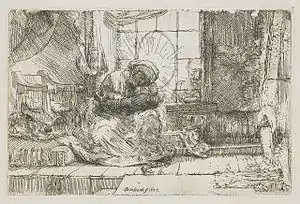Virgin and Child with a Cat
The Dutch artist Rembrandt van Rijn (1606–69) occupies a unique a position in the history of prints as he does in the history of painting. Etchings such as The Virgin and Child with a Cat, of 1654, represent the very pinnacle of printmaking as a creative art form. It is to Rembrandt that generations of etchers have constantly looked for inspiration. In its collection, the Victoria and Albert Museum has both one of the earliest impressions of this etching and the actual copper plate from which the image is taken.
.jpg.webp)
| The Virgin and Child with a Cat | |
|---|---|
 | |
| Artist | Rembrandt |
| Year | 1654 |
| Medium | Etching on paper |
| Dimensions | 9.5 cm × 14.5 cm (3.7 in × 5.7 in) |
This print shows a homely scene of maternal affection but it is also a powerful piece of Christian symbolism. While the cat on the left is playing with the Virgin's hem, a snake can be seen slithering out from under her skirt. The Virgin is treading on the snake, symbolising her role as the new Eve, who will triumph over original sin. Joseph looks in from outside the window, symbolising his closeness to, but also his separation from, the Virgin and Child. The pattern of the window's glazing creates the impression of a halo around the Virgin's head.
Bibliography
External links
 Media related to The Virgin and the Child with the Cat and Snake at Wikimedia Commons
Media related to The Virgin and the Child with the Cat and Snake at Wikimedia Commons